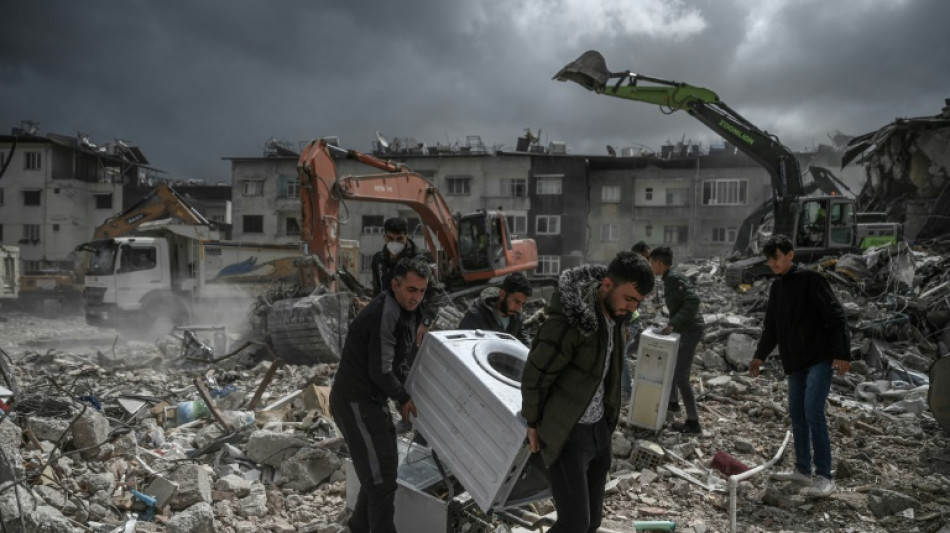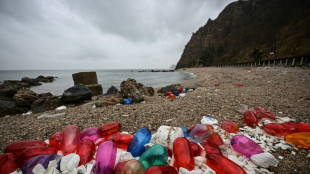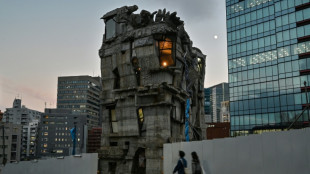

Antakya's quake victims doubt Erdogan's rebuilding pledge
Retired construction worker Ali Cimen looked at the pile of rubble raising dust over his former neighbourhood and scoffed at the idea that Turkey's earthquake disaster zone could be rebuilt in a year.
Half a dozen growling excavators were levelling what was left of the 60-year-old apartment complex in the ancient Syria-border city of Antakya.
Hundreds more swung their giant arms and raised a cacophony of noise across this mountain-ringed melting pot of ancient civilisation.
Antakya was known as Antioch until it became part of Turkey and inherited the mantle of one of the region's most free-spirited cities.
Its skeletal remains -- precariously standing since a 7.8-magnitude quake unleashed its devastation exactly two months ago -- were now being turned to rubble and dust.
What comes in their place -- and when -- is a matter of intense social and political debate.
"I don't think the reconstruction can be accomplished in a year," Cimen said, while watching his home being torn down.
"Maybe somewhere else. But here, under these conditions, removing the rubble alone will take at least a year."
- Election pledges -
Antakya bore the brunt of a calamity that claimed more than 50,000 lives and tested the leadership of President Recep Tayyip Erdogan ahead of May 14 elections.
Erdogan has made a bold campaign pledge to rebuild the entire disaster zone -- originally home to more than 13 million people -- by the start of next year.
Few of those who remain in the hollowed shell of this city believe him.
The stench of decomposing bodies wafts in with the wind from piles of uninspected rubble and random street corners.
Lines of hanging laundry betray signs of life persevering in all the emptiness and ruin.
Patches of the old city centre -- once a vibrant maze of romantic cafes and boutique shops -- remain impassable because of metres-high mounds of debris.
Erdogan told the nation on Wednesday that half the rubble had already been cleared from Antakya's Hatay province.
Retiree Gokhan Karaoglan treated Erdogan's pledges with a healthy dose of scorn.
"It's been two months and they still haven't cleared the rubble," the 54-year-old said.
"It will take another three, four or five years. Meanwhile, we live in misery."
- Tearing it all down -
The chief engineer at the demolition site said workers were under orders to raze buildings most liable to collapse first.
"Even the buildings you still see standing are damaged will eventually be torn down," Murat Sirma said.
"I think very few buildings will remain when this is all over," said the 45-year-old.
"Maybe five or 10 percent of them."
It is hazardous work. The dust is intermixed with cement and poisonous material such as asbestos -- an insulant linked to cancer.
Huge chunks of buildings often come crashing down in a tidal wave that covers the entire site in tall plumes of noxious dust.
The workers tend to wear face masks. Locals who gather to watch the destruction do not.
"There are 1,000 excavators working in Hatay," Sirma said. "That's a huge amount of work."
- 'The living dead' -
Heavy lorries piled high with the rubble clog that city's outer roads.
They trundle towards one of a handful of government-designated landfills that are then doused with water to keep down the dust.
Many in Antakya appear so subsumed by shock and grief that they fail to clearly visualise a future that comes after all the debris is removed.
Turkey's record of rebuilding historic cities is blemished by the example of Diyarbakir -- a mostly Kurdish city whose twice-reconstructed old town lacks much of the original's charm.
Engineer Sirma said the new plans for Antakya's construction would be laid down once all the rubble is removed.
Emina Burc could not think that far ahead.
The 39-year-old divorcee joined a handful of others to watch excavators tear down the remains of her home.
"To be honest, I feel like we're the living dead," she said.
But Karaoglan said he was clinging on to hope.
"This is where I was born, this is where I built my home, and this is where I will eventually die," he said.
O.Ratchford--NG



